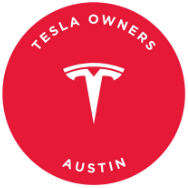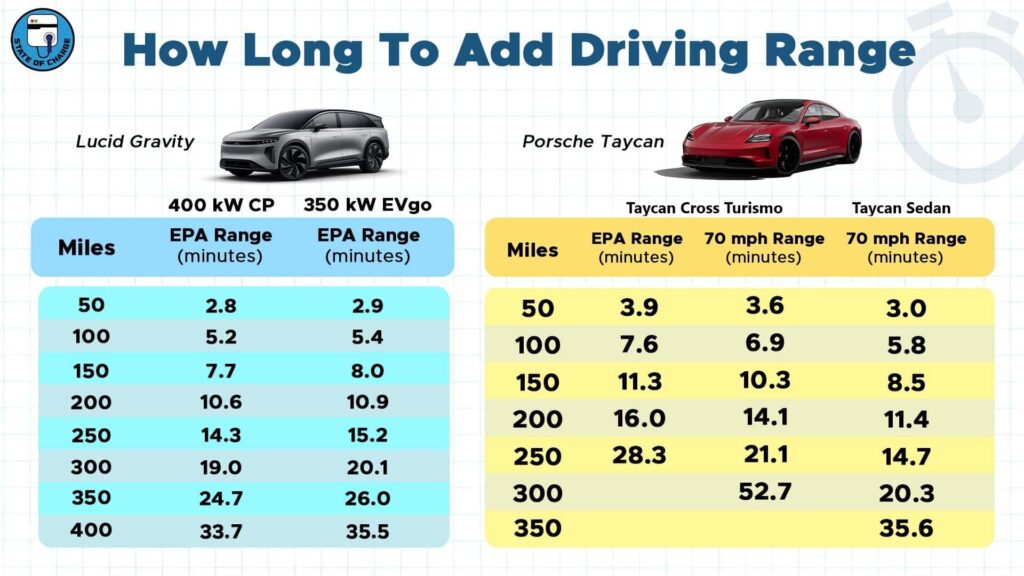The United States may not have the five-minute fast-charging capabilities for electric vehicles like China does, but that doesn’t mean that progress isn’t being made in the EV market. Two of America’s fastest-charging EVs currently on the market are the 2025 Porsche Taycan and the 2026 Lucid Gravity. These vehicles are equipped with high-voltage electric architectures, advanced motors, and batteries that are focused on efficiency and fast charging.
The Lucid Gravity can theoretically accept up to 400 kW of peak charging power, while the Taycan is rated at up to 320 kW. In a recent head-to-head test conducted by InsideEVs Contributing Editor and State of Charge YouTube channel host Tom Moloughney, these two fast-charging EVs were put to the test. The average session at a DC public fast-charger in America was around 42 minutes in 2024, according to the U.S. Department of Energy. However, real-world charging times vary based on factors such as battery size, starting charge level, charger speed, and weather conditions.
In the test, both the Taycan and the Gravity were connected to a 350 kW station under the same conditions, starting from 0% charge. The Gravity began pulling 350 kW speeds almost immediately, while the Taycan took a minute to ramp up. After five minutes, the Taycan had a higher charge level due to its smaller battery, but the Gravity was receiving more energy at higher speeds. At 10 minutes, the Taycan was at 48% charge and 311 kW speeds, while the Gravity was at 42% and 277 kW. By 19 minutes, the Taycan reached 80% charge, while the Gravity was at 64%, still pulling faster charging speeds.
Despite reaching 80% charge faster, the Taycan would provide fewer driving miles than the Gravity at the same charge level. The Gravity eventually hits 80% charge in 27 minutes, showcasing its faster charging capabilities compared to the Taycan. As EV technology continues to evolve, faster charging times and increased efficiency are becoming more prevalent in the market, bringing us closer to the convenience of quick refueling for electric vehicles. In a recent comparison test conducted by Tom from the YouTube channel “More on that in a bit,” the Porsche Taycan and the Lucid Gravity faced off in a charging speed challenge. The results were surprising, to say the least.
Initially, it seemed like the Taycan was the clear winner, as it reached 100% battery capacity after just 53 minutes, while the Lucid Gravity took 74 minutes to reach full charge. However, Tom pointed out a crucial detail that changed the narrative. The Gravity’s charger dispensed 10 more kilowatt-hours, which could account for an additional 40 to 50 miles of driving range. This factor had to be considered in the final assessment.
Tom emphasized the importance of the low-to-80% charging speed, especially for luxury electric vehicles with larger batteries like the Taycan and Gravity. Both cars were able to charge from empty to 80% in under half an hour, which Tom found impressive. He described them as “charging beasts” and claimed they were the fastest charging electric vehicles currently available in North America.
Despite the impressive performance of both vehicles, Tom noted that the Gravity was somewhat handicapped in the test. It was using a 350 kW charger, while it has the capability to charge at up to 400 kW. Unfortunately, there are very few 400 kW chargers available, and 350 kW is considered the best option among widely accessible chargers. This raised questions about the Gravity’s true potential and left room for further exploration in future tests.
Overall, the comparison test between the Porsche Taycan and Lucid Gravity showcased the impressive charging capabilities of both vehicles. The results highlighted the advancements in electric vehicle technology and the rapid progress being made in the EV industry. As electric vehicles continue to gain popularity, fast charging speeds will be a key factor for consumers looking to make the switch to sustainable transportation. The Gravity electric vehicle has been put to the test once again, this time with data from a charging test using a 400 kW charger. The results show that the Gravity outperforms other electric vehicles when it comes to adding actual miles of driving range, rather than just a battery percentage number.
In a comparison with other electric vehicles, the Gravity emerges as the clear winner in terms of charging efficiency and speed. With the ability to utilize a 400 kW charger, the Gravity is able to add driving range at a faster rate than its competitors.
According to Tom, an expert in the field, the advancements in charging technology that have been seen in China will likely make their way to the United States in the near future. This suggests that the fast-charging capabilities demonstrated by the Gravity could become more common in EVs across the country.
Overall, the Gravity’s performance in charging tests highlights its potential to revolutionize the electric vehicle market. With its ability to quickly add driving range and outperform other EVs in charging efficiency, the Gravity is a strong contender in the rapidly evolving world of electric vehicles.

